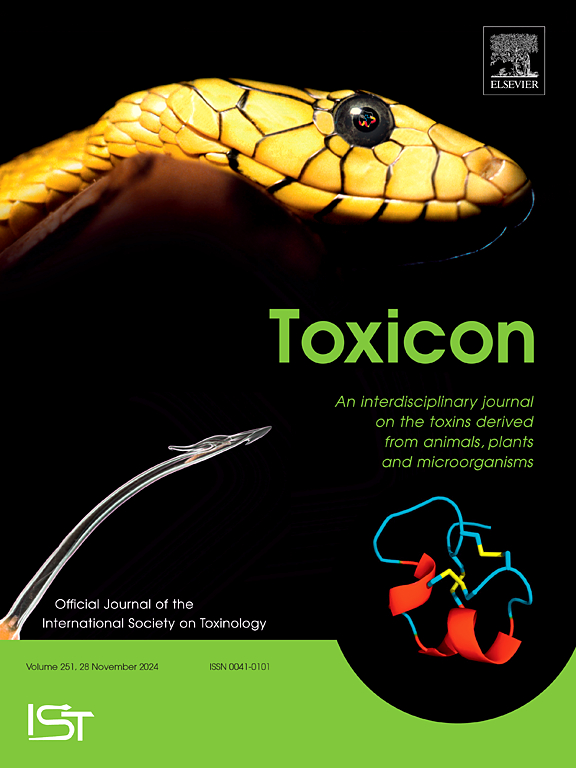同时去除多种霉菌毒素的研究多样性和进展。
IF 2.4
4区 医学
Q2 PHARMACOLOGY & PHARMACY
引用次数: 0
摘要
霉菌毒素是不同真菌物种在特定环境条件下产生的有毒次级代谢产物。常见和受管制的霉菌毒素包括脱氧雪腐镰刀菌烯醇(DON)、玉米赤霉烯酮(ZEN)、赭曲霉毒素(OTA)、黄曲霉毒素 B1(AFB1)和伏马菌素(FB)。这些霉菌毒素在饲料和食品中受到严格管制,因为它们的影响从最低接触量开始产生,而且在我们的常见环境中大量存在。不过,还有其他新出现的霉菌毒素,如芹菜素、贝维菌素、呋喃菌素和烯萘菌素,也对人体有害。因此,霉菌毒素的种类共有约 500 种。饲料和食品中霉菌毒素的存在对动物和人类健康产生了重大影响,最终导致全球经济增长放缓。根据这份综述,人们提出了分别或同时去除多种霉菌毒素的不同方法。综述主要侧重于同时去除不同的多种霉菌毒素。这是因为目前的研究表明,饲料和食品原料中同时存在多种霉菌毒素的报告呈上升趋势,但大多数解毒方法都是针对单一霉菌毒素的。因此,作者阐明了去除多种霉菌毒素的物理、化学和生物方法及其优势和局限性。此外,作者还就今后如何减少霉菌毒素的摄入量并降低其对社会健康的影响提出了建议。最后,作者强调要对同时存在的霉菌毒素实行更严格的限制,特别是那些通过协同作用对健康产生相同影响的霉菌毒素,如 AFB1 和 OTA,它们都是致癌物质。本文章由计算机程序翻译,如有差异,请以英文原文为准。

Research diversity and advances in simultaneous removal of multi-mycotoxin
Mycotoxins are toxic secondary metabolites produced by different fungal species under specific environmental conditions. The common and regulated mycotoxins are such as deoxynivalenol (DON), zearalenone (ZEN), ochratoxin (OTA), aflatoxin B1 (AFB1), and fumonisins (FB). These mycotoxins are highly regulated in feed and food because their effects start to exert from their lowest exposures and are abundant in our common environment. However, there are other emerging mycotoxins such as apicidin, beauvericin, aurofusarin, and enniatins which are also harmful. Thus, making a total of around 500 forms of mycotoxins. The existence of mycotoxins in feed and food has a significant impact on animal and human health, which ultimately, slows down economic growth globally. According to this review, different approaches to removing multi-mycotoxin separately or simultaneously have been stated. Mostly, the review focused on the simultaneous removal of different multiple mycotoxins. This is because the current studies show a growing trend in reporting the co-existence of multiple mycotoxins in feed and food materials, however, most detoxifying approaches are for singular mycotoxins. Therefore, the physical, chemical, and biological approaches to remove multi-mycotoxin have been elucidated as well as their advantages and limitations. Furthermore, the authors give suggestions on the way forward to reduce exposure to mycotoxins and diminish their health effects in society. Lastly, the authors emphasized introducing more stringent limits for co-existing mycotoxins, especially those that have the same health effects by acting synergistically, such as AFB1 and OTA, which both act as carcinogenic agents.
求助全文
通过发布文献求助,成功后即可免费获取论文全文。
去求助
来源期刊

Toxicon
医学-毒理学
CiteScore
4.80
自引率
10.70%
发文量
358
审稿时长
68 days
期刊介绍:
Toxicon has an open access mirror Toxicon: X, sharing the same aims and scope, editorial team, submission system and rigorous peer review. An introductory offer Toxicon: X - full waiver of the Open Access fee.
Toxicon''s "aims and scope" are to publish:
-articles containing the results of original research on problems related to toxins derived from animals, plants and microorganisms
-papers on novel findings related to the chemical, pharmacological, toxicological, and immunological properties of natural toxins
-molecular biological studies of toxins and other genes from poisonous and venomous organisms that advance understanding of the role or function of toxins
-clinical observations on poisoning and envenoming where a new therapeutic principle has been proposed or a decidedly superior clinical result has been obtained.
-material on the use of toxins as tools in studying biological processes and material on subjects related to venom and antivenom problems.
-articles on the translational application of toxins, for example as drugs and insecticides
-epidemiological studies on envenoming or poisoning, so long as they highlight a previously unrecognised medical problem or provide insight into the prevention or medical treatment of envenoming or poisoning. Retrospective surveys of hospital records, especially those lacking species identification, will not be considered for publication. Properly designed prospective community-based surveys are strongly encouraged.
-articles describing well-known activities of venoms, such as antibacterial, anticancer, and analgesic activities of arachnid venoms, without any attempt to define the mechanism of action or purify the active component, will not be considered for publication in Toxicon.
-review articles on problems related to toxinology.
To encourage the exchange of ideas, sections of the journal may be devoted to Short Communications, Letters to the Editor and activities of the affiliated societies.
 求助内容:
求助内容: 应助结果提醒方式:
应助结果提醒方式:


